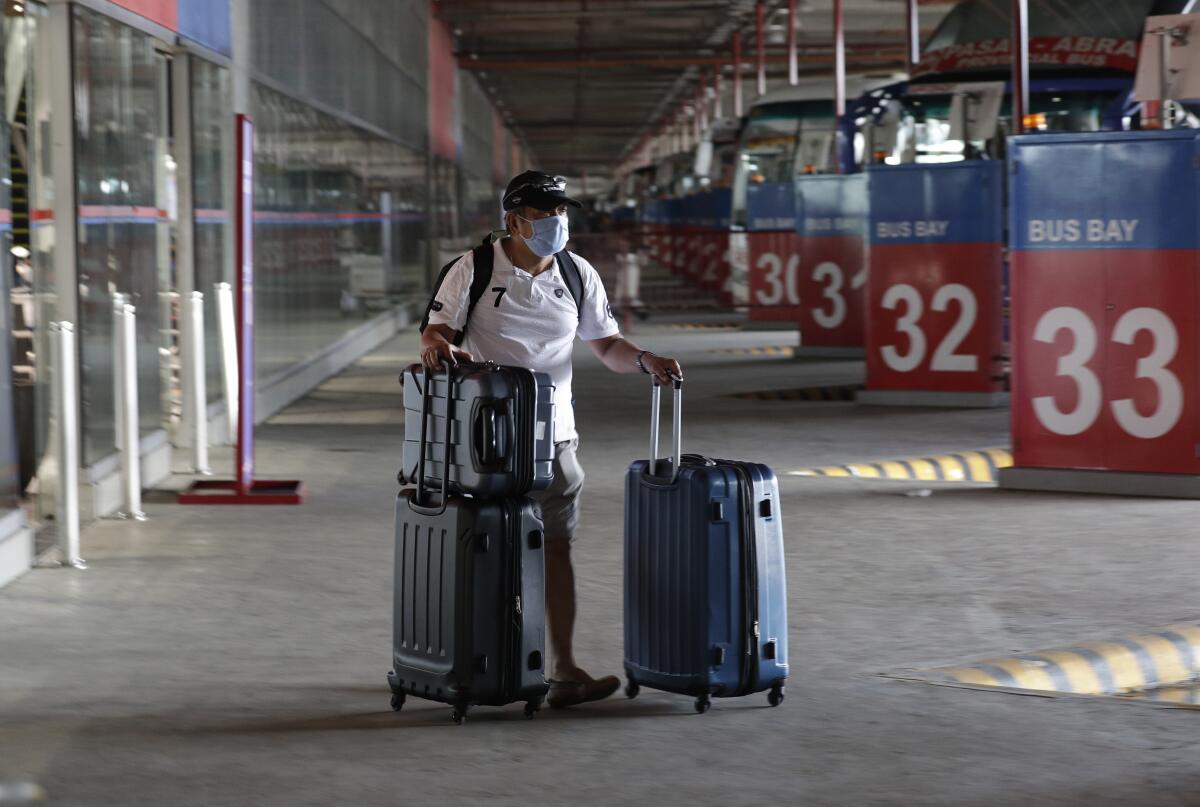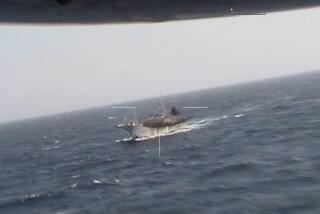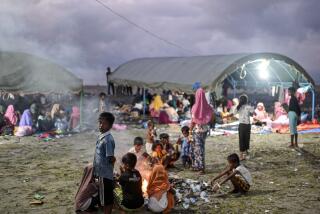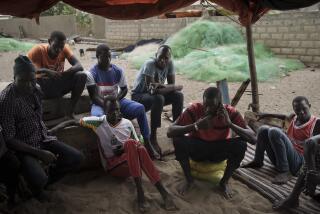Philippine fishermen stranded at sea by pandemic: ‘We think about jumping overboard’

- Share via
MANILA — Anthony Medina’s daughter was 5 months old when he left the Philippines and set sail for the Indian Ocean in December 2018 on an odyssey where his livelihood collided with a pandemic that has kept him adrift at sea and exiled from home.
For more than a year, his days have been a monotonous blur of endless fishing on the Oceanstar 86, a 465-foot-long vessel with a crew of about three dozen. As long as there was seafood for their nets, including tuna, crab and squid, the crew members had to haul them in, clean and freeze them.
When their boat arrived in Singapore in March, Medina planned on catching a flight home. But he was shocked to learn that a virus outbreak had closed borders and shuttered ports, keeping him out of the Philippines and trapped on the fishing boat.
“We were prohibited from disembarking,” said Medina. “Our airline ticket was canceled.”
News about the coronavirus outbreak had upended the globe by then. But because the boat was isolated on the high seas and cut off from the rest of the world, information was limited to what senior crew members shared. The language barrier between the Chinese management on board and the Philippine, Indonesian and Burmese crew didn’t prepare Medina for a world that had ground to a standstill to prevent the spread of COVID-19.
“We didn’t have a signal out in the middle of the ocean,” said Medina. “We heard the captain saying something about a pandemic, but we thought it was just a joke — nothing as bad as this.”
An estimated 300,000 migrant seafarers like Medina are languishing mostly forgotten on stranded vessels scattered across seas or in ports because of the pandemic, according to the International Transport Workers’ Federation, a London-based trade union. By comparison, there are usually 400,000 merchant sailors at sea year-round during normal times.
The Philippines, which has a maritime history that dates back to Spanish colonial rule, is at the center of the crisis. The island archipelago supplies about a quarter of the world’s 1.2 million seafarers because of limited jobs at home. Last year, those hired hands sent home $6.14 billion in remittances — a cornerstone of the Philippine economy.
Medina and 37 other sailors have been in limbo for more than six months, anchored off Fuzhou, China. Days seep into night and boredom mixes with restlessness and despair. They have become men without countries, castaways and captives in the narrative of an unrelenting pandemic.
“The shore is so near that we can see it from here,” he said. “On the really bad days, we think about jumping overboard and swimming to shore. Maybe we can be rescued.”
Unable to reach land because of entry restrictions, the crews toil on boats that are running out of drinking water. Some vessels are unable to replace crew members, forcing already exhausted seafarers to work several more months than planned.
The Philippines tries to lure its nurses to stay to help on front lines against COVID-19, but a legacy of exploitation frustrates the effort.
“Most urgent now is their survival,” said Rossen Karavatchev, fisheries section coordinator for the International Transport Workers’ Federation. “The longer this lasts, the harder this will be. Being anchored in the middle of the ocean for a long period of time is not tenable.... If you get sick on board, sorry, you can’t get medical assistance and you can’t get out. If you die, you may be thrown into the sea for a sea burial.”
Medina gave up odd jobs in construction for the steady $350 monthly salary fishing provided and its promise of an escape from poverty. But life at sea has proved to be worse than destitution on land. He now endures sleepless nights with not enough water to drink or bathe with to wash off the stench and slime of fish.
A video taken by the 11 Philippine crew on the Oceanstar 86 showed men sleeping on the floor of the laundry room and under tables in what appears to be a kitchen. They heat what little food they have in a kettle.
“We don’t have any more filtered water. We boil the water that comes out of the sink, but it is brown and rusty and tastes bad,” said Medina, who worries about the fate of the crew members and their families back home who depend on their salaries. Their contract ended in November, and they are uncertain if they will get paid for working while quarantined at sea.
The Philippine Consulate in Xiamen, China, has been sending the crew supplies, but Eduardo Mendez, spokesman for the Department of Foreign Affairs in Manila, said logistics makes it difficult to send supplies regularly.
On average, fishing crews are at sea for about 11 months at a time. The crisis brought on by the pandemic has forced contract extensions and has many sailing indefinitely. Maritime groups report some seafarers now sailing for 17 to 21 months. An International Transport Workers’ Federation study conducted by Yale University showed that seafarers experience “dangerously high levels of mental stress” and have contemplated suicide more than those in any other occupation.
The crisis has also underscored the vulnerability of migrant crewmen on vessels with spartan living conditions and notoriously exploitative labor practices that have been compared to slavery — even before the coronavirus outbreak.
The International Labor Organization estimates that there are about 41,000 migrant fishers around the world, mostly from Southeast Asia. The actual number could be as high as 100,000 because many are undocumented or trafficked into sailing in international waters.
In May, a video of the makeshift burial at sea of an Indonesian fisherman sparked outrage and allegations of abuse. An investigation revealed that three Indonesian fishermen on board the Long Xing 629 Chinese fishing vessel had died at sea. Rescued crew shared stories of maltreatment, physical abuse and lack of medical care.
Videos from other stranded migrant fishers in Sri Lanka and China tell similar stories of squalid living conditions, crew members falling sick and others dying.
At the same time, the macho culture and ship hierarchy promote the stoic toughness of so-called boat face, which prevents the crew from showing any emotion. “You’re talking about men who have tales of surviving waves that are taller than skyscrapers. Fear and depression are hard to admit and even harder to talk about,” said Lala Tolentino, country director of the welfare organization Mission to Seafarers in Manila.
Maritime experts say migrant fishers do not always have the same protections as merchant sailors because of their ambiguous classification; some laws and treaties consider them seafarers while some do not. Additionally, not all fishing vessels have tracking systems or purposely shut them off to avoid detection of overfishing or trespassing into protected waters.
Only 13 countries have signed the International Maritime Organization health protocols for safe disembarkation amid the pandemic.
Zara Alvarez was at least the 90th victim of an extrajudicial killing on the Philippine island of Negros under the Duterte administration.
As the global economy remains battered by the pandemic, maritime agencies warn of a potential increased risk of ship owners abandoning boats and their crew amid the mounting costs of maintaining their fleets. Seafarers’ Rights International includes nonpayment of wages and a shrinking supply of food and water on board as early signs of possible ship abandonment.
Already 21 ships have been reported abandoned as of July, 15 fewer than all of last year, according to a database compiled by the Geneva-based International Labor Organization.
“The vast number of shipping companies are trying to do the right thing. But various governments are not allowing crew changes. The rate of progress is not at the pace that we need,” said Frederick Kenney, director of legal affairs for the International Maritime Organization.
In Montevideo, Uruguay, Philippine fisherman John Lester Jugcal recently stepped on land for the first time in almost two years.
Jugcal had been stranded at sea for more than three months. Like the other sailors on his ship, he heard about COVID-19 when his return to the Philippines was blocked by port closures and border restrictions. The death of a crew mate, Rodel Catinoy, of unknown reasons while aboard, haunts Jugcal and the other men and taints the anticipation of going home.
“We don’t know where his body is,” said Jugcal. “We heard it was placed on a boat now fishing in Peru. We hope his remains are returned to his family. It isn’t right if they don’t get to say goodbye to him.”
Medina, meanwhile, sits off the coast of China, with no way to get home to his daughter, who is no longer an infant.
Santos is a special correspondent. Reporting for this article was supported by a grant from the Pulitzer Center on Crisis Reporting.
More to Read
Sign up for Essential California
The most important California stories and recommendations in your inbox every morning.
You may occasionally receive promotional content from the Los Angeles Times.











